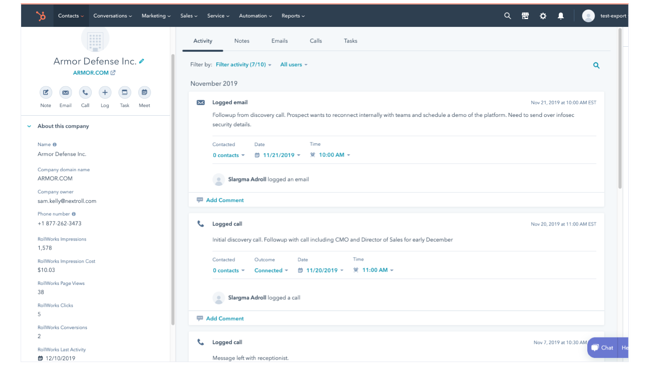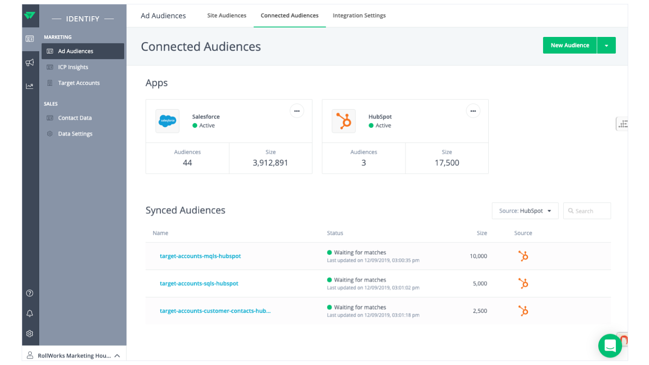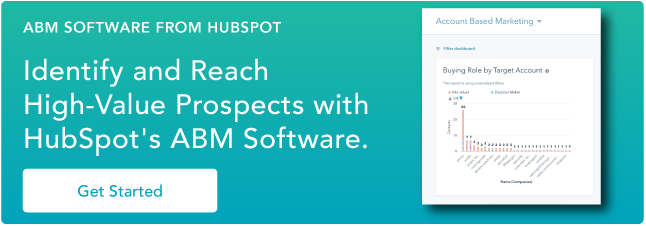Today, marketing is all about personalization.It’s about reaching the right people in the right place at the right time. Account-based marketing (ABM) is no different — it’s a strategy that’s been growing in popularity in recent years. In fact, 94.3% of respondents to a 2020 State of ABM survey use an ABM strategy.
That’s why ABM is an important strategy to implement if you sell high-value B2B products or services to a finite number of companies with several decision makers. Using ABM automation tools is the key to scaling these efforts.
Here, we’ll show you exactly how to automate your account-based marketing strategy using ABM automation tools.
Learn More About HubSpot’s ABM Software
1. Scalable Acquisition Strategy
We know that anytime a process is automated, it’s scalable. When ABM strategies are automated, bandwidth on your marketing team becomes available. Your team can spend more time nurturing the accounts they’re responsible for and personalizing the sales cycle for the decision makers within the account. That way, new business can be acquired without the limitations of manually nurturing each account.
2. Shorter Sales Cycle
Consider this: When your sales reps have just a few accounts to target to close deals, they can become more selective about who moves through the sales cycle and when. When a specific marketing tactic works to generate leads in a particular account, the sales rep can shift their focus to that deal. ABM automation benefits sales reps by incentivizing them to work efficiently to close deals which leads to shorter sales cycles.
3. Better Marketing and Sales Alignment
For far too many marketing and sales teams, alignment between the two seems to be a goal instead of reality. An automated account based marketing strategy causes and requires alignment between these two business functions in order to close deals.
The marketing team is responsible for creating sales enablement content while the sales team is responsible for cultivating the relationships and closing deals. Without both of these parts of the puzzle working together, the ABM strategy would fail. Automating the strategy by producing content at scale and tracking accounts through the sales process using ABM automation tools like RollWorks keeps both teams aligned and achieving their goals.

4. Stronger Customer Retention
Leveraging personalized marketing and sales materials for each account is a fundamental tactic used in account based marketing. But that can be difficult to maintain if your team is doing this manually. Eventually, the personalized materials transform into more general content and the relationship between your business and the account fizzles out.
With ABM automation, this doesn’t have to be the case. Automating emails and direct mail campaigns (just to name a few) throughout the account’s life cycle can strengthen the relationship, yielding improved customer retention and satisfaction.
1. Create your Ideal Customer Profile (ICP).
Before you can get started with ABM, you’ll need to define your ideal customer profile. This is similar to a buyer persona, except it’s built around targeting entire organizations rather than individuals.
You’ll want to know what types of companies you want to target. For example, your ICP should include information on company size, revenue, industry, and location.
With software, like HubSpot’s ABM software, you can use ICP workflow templates to help you spot common traits that can be used to classify companies in your database by how well they match your ICP.
Ultimately, automation should help you identify and organize your target accounts. Once you’ve created your ICP, you should be able to use this information in your ABM software to manage your audience.
2. Set up your target accounts.
Once you’ve created your ICP, you should be able to set up your target accounts in your ABM software.
Tagging “Target accounts” in your software will enable you to manage your audience from a Target Accounts dashboard. For example, with HubSpot’s ABM software, you can tag accounts as target accounts and then rank them with the ICP Tier property. Your priority accounts will be marked “Tier 1,” while lower priority accounts will be marked “Tier 3.”
Additionally, a great ABM software will use AI-powered target account recommendations to automate the process of researching companies that are a good fit.
These types of tools will help you manage and then segment your lists so you can deliver personalized content to your target accounts.
3. Integrate your ABM, marketing automation software, and CRM.
Before you can build your ABM campaigns, you’ll want to integrate your ABM software with your marketing automation software and your CRM.
For example, with HubSpot, you can use many of the ABM software features if you have Marketing or Sales Pro.
Integrating your marketing tools is important in the automation process. If your ABM software doesn’t interact with your email marketing software or your ads tools, then you won’t be able to automate the process.
Additionally, if it doesn’t interact with your CRM, it’ll be impossible to know if leads become accounts and track the ROI of an account-based campaign.
By integrating these tools, you’ll have your ICP research, target accounts, content, and CRM all in one place.
4. Build your campaigns.
When you have your ABM software and marketing tools set up, it’s time to create your campaigns.
To start, you’ll want to decide what channels you want to use and what actions will trigger an automated workflow.
First, look at your target accounts and find out where they spend their time online. For example, you can build an ad campaign based on people’s job titles or companies on LinkedIn and Facebook.
Then, you’ll want to think about your customer journey and set up automated workflows. For instance, you can have a task created for a sales rep when someone who works at one of your target accounts interacts with an email, your website, or blog content.
5. Personalize your content.
You probably got started with ABM so you could personalize your marketing campaigns. To do this, you’ll want to create your content, and use your automation tools to segment your audience.
For example, with HubSpot’s ABM software, you can use company lists to create an ad audience or use company ad targeting for your LinkedIn ads.
With your ICP set up, you can create your content based on your target audience. The content in your ABM campaigns will be similar to other marketing content, except that you’re now targeting specific accounts and companies.
Ultimately, your messaging should address specific pain points, and appeal to solving your target account’s problems.
6. Tailor your engagement.
Another aspect of your ABM strategy will be collaborating with your sales team so they can tailor their engagement with target accounts.
A great way to do this is through automation tools. That’s why your CRM and ABM software need to work together.
For example, with HubSpot’s ABM software and Sales Hub, you can automate your follow up emails and tasks based on the prospect’s behavior.
However, remember that even though you’re focusing on automation right now, your sales outreach and content should still be personalized.
7. Set up a dashboard to assess ongoing efforts.
The last step to automating your ABM strategy is to track and measure your efforts. With ABM software, you’ll want to see information at-a-glance.
For instance, on your dashboard, you might include information on your target accounts such as company score, open deals, total pipeline, and the number of decision-makers identified.

If your ABM software has company scoring available, you should use it. This is similar to lead scoring, where you assign a score based on the properties in your software.
Additionally, you should consider running A/B tests when you get started with ABM automation so you can see what messaging appeals to your ICP.
While ABM does require thoughtful planning and coordination, using ABM software tools — ideally ones that integrate with your CRM and marketing automation tools — can help you automate and scale your strategy.
Editor’s note: This post was originally published in May 2020 and has been updated for comprehensiveness.
![]()


